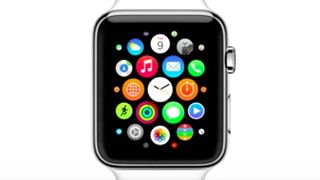Apple Watch Credited with Saving Life: What Conditions Can It Detect?

A Massachusetts teen says the Apple Watch saved his life, by alerting him that his heart rate was much higher than normal, leading to a diagnosis of a life-threatening condition. Experts say the gadget — and similar devices — could potentially detect alterations in people's heart rates that might be a sign of health problems.
Paul Houle Jr., a high school senior, said he felt back pain after two football practices on the same day, but he didn't think much of it, according to Huffington Post. However, he later noticed his Apple Watch revealed that his heart rate was 145 beats per minute — about double his normal rate. Although he thought the watch might be broken, Houle told his athletic trainer, and after an exam, was taken to the emergency room.
Houle was later diagnosed with rhabdomyolysis, a condition in which muscles release a protein that damages the kidneys and other organs, and can cause a rapid heart rate. Houle had suffered damage to his kidneys, heart and liver.
"Doctors told me that if I had not said anything and [had] gone to practice the next day, I very easily could have died," Houle told the Huffington Post. [What Is a Normal Heart Rate?]
It's important to note that the Apple Watch is not a medical device, and cannot be used to diagnose heart conditions. But because the device monitors heart rate, it could potentially alert people to a health problem that should be evaluated, said Dr. Allen Taylor, a cardiologist and professor of medicine at Georgetown University School of Medicine in Washington, D.C.
"Heart rate is a general signal for how much stress your body's under," Taylor said. The stress could be due to exercise, mental stress or an illness, he said.
Like a fever, a high heart rate could be a symptom of many conditions, and so it cannot be used for a diagnosis by itself, Taylor said. But "For certain conditions, [if] patients find their heart rates running faster, it could alert them to say 'something's not right here,'" Taylor said.
Sign up for the Live Science daily newsletter now
Get the world’s most fascinating discoveries delivered straight to your inbox.
Other conditions that might be detected by a heart rate monitor include:
- Atrial fibrillation, or an erratic heartbeat, might be detected by a heart rate monitor, Taylor said. An episode of erratic heartbeat can last for seconds, minutes or days, and the symptom isn't always present when a patient goes to the doctor. That's why self-detection of the condition can be important, Taylor said.
- Anemia, or a low red blood cell count. This condition can cause problems with the heart's electrical impulses and lead to a faster-than-normal heartbeat, according to the Mayo Clinic.
- Overactive thyroid. When the thyroid gland produces too much thyroid hormone, this can also interfere with the heart's electrical activity and lead to a fast heart rate, even one of more than 100 beats per minute, the Mayo Clinic says.
A heart rate monitor might also be useful for patients who are taking medications to prevent a rapid or erratic heart rate, so that doctors could see if the medications are working, Taylor said.
Dr. Ragavendra Baliga, a cardiologist at The Ohio State University Wexner Medical Center, noted that a new app for the Apple Watch, called AirStrip, can allow doctors to view patients' vital signs, including their heart rates. For people with heart failure, which can cause a rapid heart rate, doctors could use AirStrip to make adjustments to the patient's medications, Baliga said.
However, it's also possible that some patients might be overly assured by monitoring their heart rates, and believe that nothing is wrong if they have a normal heart rate, Taylor said.
"A normal heart rate doesn't mean you're not sick," Taylor said. For example, a heart rate monitor can't detect if you're having a heart attack.
Still, overall, wearables have the potential to empower patients to think about their health in news ways, Taylor said. "Whether it's detecting conditions early, or whether it's monitoring conditions, or whether it's just having grater self-awareness of their health …There're so many potential advantages" to wearables, he said.
Follow Rachael Rettner @RachaelRettner. Follow Live Science @livescience, Facebook & Google+. Original article on Live Science.

Rachael is a Live Science contributor, and was a former channel editor and senior writer for Live Science between 2010 and 2022. She has a master's degree in journalism from New York University's Science, Health and Environmental Reporting Program. She also holds a B.S. in molecular biology and an M.S. in biology from the University of California, San Diego. Her work has appeared in Scienceline, The Washington Post and Scientific American.
